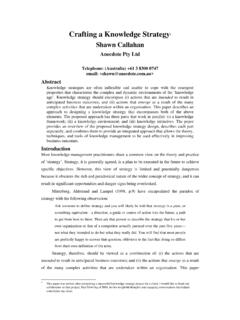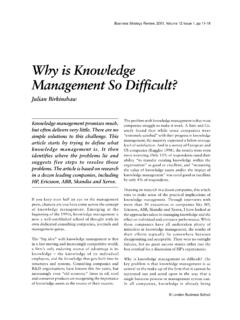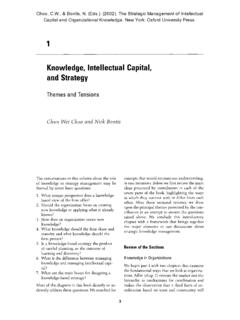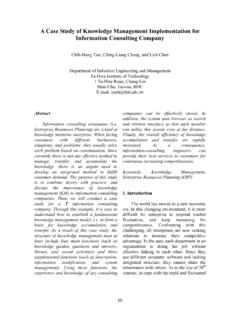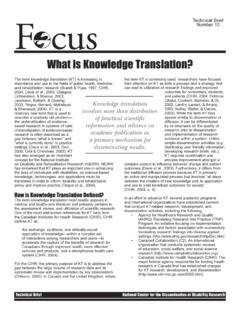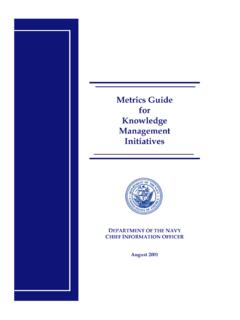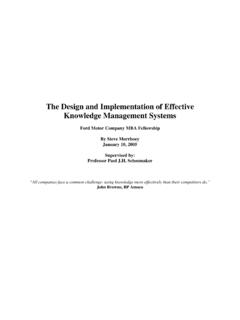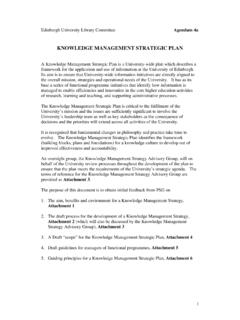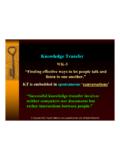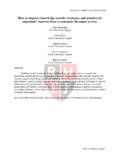Transcription of Aligning Knowledge Management with Business Strategy
1 AligningKnowledge Management with Business StrategyBrian (Bo) Knowledge Management Themes What is Knowledge Management ? What does it mean to align KM with Business Strategy ? The theoretical foundations for alignment Charting a course for good alignment Putting technology in contextWhat isKnowledge Management ?What isKnowledge Management ?Who cares? It has been coming It needed a name Knowledge Management is the one that we gave itWhat does it mean to alignKM with Business Strategy ?It means that you have suboptimized!Why? The problem is with the word with with implies subordination It should be and KM andBusiness Strategy should Influence each other Align with each other Together, define a point of mutual alignmentBut, That Still isn t Enough If you only align KM and Business Strategy , you are still suboptimizing KM has emerged as the dominant metaphor for understanding alignment problems Aligning only KM and Business Strategy ignores important facetsAlignment should Encompass and Integrate all Approaches Information Management Learning Organizations Systems Dynamics Human Resources Management Workflow Management Organizational Governance Business Process Reengineering Data Warehouses Document Management Intellectual Property Activity-Based Management Imaging Data Mining Artificial Intelligence E-commerceThe TheoreticalFoundations for AlignmentThe TheoreticalFoundations for Alignment The multi-dimensional nature of alignment The situational nature of alignment The elements of alignmentThe Multi-DimensionalNature of Alignment The various dimensions of alignment reflect distinct conceptual viewpoints These include.
2 The Knowledge Lifecycle Behavioral slack Static vs dynamic Engineered vs organic The Knowledge Utilization event (KU) And many, many othersThe Knowledge Lifecycle The Knowledge Lifecycle comprises 4 major patterns of activity Knowledge Development Knowledge Retention Knowledge transfer Knowledge Utilization These activity sets cannot fully support a Business Strategy until each is aligned in the context of a Knowledge LifecycleBehavioral Slack Most Management practices ( , ABM, BPR, Kaizen) focus on individual and organizational behaviors But they virtually ignore alignment behaviors The key to all alignment behaviors is behavioral slackStatic vs Dynamic Artifacts and transformations Facts and truth Core values and alignment values Single-point alignment and ongoing alignment Value sets and value spacesEngineered vs Organic The two are not mutually exclusive It s important to strive for a correct balance between engineered and organic approaches A workable balance is context-specific Lack of balance makes alignment points Sporadic and unstable (overly organic/class 4) Brittle and short-lived (over-engineered/class 2)The Knowledge Utilization Event (KU)
3 Cornerstone of the Knowledge Lifecycle Emphasizes the importance of intelligent behaviors Decisions Actions Focus of all alignment vectorsThe SituationalNature of Alignment Each behavior is a response to a given situation You can predict alignment, you can plan for it, you can attempt to manage You can only evaluate alignment by examining the results of the behaviors exhibited in a given situational contextThe Elements of Alignment Behavior exists within a conceptual context that reflects the value space of the agent The critical elements of alignment include: Conceptual frameworks Value sets Exhibited behaviors ResultsCharting a Course forGood AlignmentCharting a Course forGood Alignment You can attempt to align Conceptual frameworks Value sets Exhibited behaviors Results Each approach has advantages and limitationsRough Roads to Avoid Aligning results through performance targets Aligning behaviors through policy Aligning conceptual spacesAligning Results through Performance Targets Preserves behavioral autonomy Hard to predict the results that will reflect optimal future balance Risks re-enforcing the predictable and mundane May focus attention away from opportunities Risks creating failure by formalizing unreasonable expectations Where appropriate behaviors are difficult to predict Where results are hard to control due to significant externalitiesAligning Behaviors through Policy Directives can be very clear and precise Risk of ignoring context and/or results (may drive misalignment)
4 Doesn t influence or address root causes of behavioral misalignment Aligning Conceptual Spaces Can drive very strong alignment But it is like teaching a pig to dance It is very hard to do (slow and expensive, huge education costs) It pisses off the pig (drives cultural resistance) It actually damages the pig Reduces individual and organizational value Undermines the unique insights that are crucial to self-worth, organizational responsiveness, and resiliencyA Smoother Road: Aligning Value Spaces KUs (decisions and actions) developed in the context of an aligned value space are Less disruptive and more easily accepted More aligned with all relevant perspectives Better adapted to new situations or contexts This produces alignments that Are less fragile Have greater longevity Produce greater strategic valuePutting Technologyin ContextWhat is a Technology? Technologies codify expected KUs and their underlying Knowledge Transforms Values Conceptual frameworks Technologies are subject to all the same alignment elementsThe Importance of Context Technologies act as agents Technologies are enablers that bring value to Knowledge It is how they are used in a behavioral context that determines the magnitude and direction of the value vectorThe Consequences ofMisaligned Technologies Suboptimized, localized solutions that will not scale or provide true strategic value Political and cultural resistance DiseconomiesYou can end up shootin yourselfin the foot with the other cowboy ssilver bulletThe Truth There is no one answer Your truths ( , the right answers for you) can only be found within your context Your true strategic context results from the alignment of your values, your needs, and the tools and techniques that enable your Knowledge lifecycl
